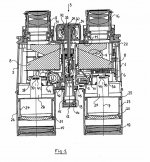I’m immensely enjoying this discussion. Especially for the contributions by F88 and Paskman. They motivated me to really question my opinions, judgements, loyalties, taste and all kinds of other motives in play here.
Renze
I very much agree - it's a discussion that tells us more about us posters than about the binoculars, thus far, but enjoyable despite (or because of) that...
Some off the cuff thoughts (getting way past my bedtime), careering randomly from prisms to ergonomics to eccentrics:
- Do Uppendahl prisms offer any optical (or other) advantages over modern day Schmidt-Pechans? Neither have total internal reflection like Abbe-Koenigs; both will require reflective coatings, and the Uppendahl advantage of having fewer air to glass surfaces is largely negated by modern multi-coatings.
- It's possible to make a superb binocular with the Schmit-Pechan system; that's what's used in most of today's alphas, after all...
- The view through the new old Trinovids should be (and ought to be) better than any of the originals, what with phase-coated prisms, modern multi-coating and all. (Did the Leitz Trinovids ever get multi-coated? It would seem from trawling previous BF posts that they were never phase-coated.)
- The body/ergonomics of the new old Trinovids should be comparable to the originals, regardless of the prism system in them; and...
- I'd agree with the two previous commentators that roof prism binoculars handle better, generally speaking, than porros - less so perhaps for things like 8x30s, but in the 40x and x50 sizes it becomes more marked. After noting Stephen Ingraham's comments about porros instinctively promoting a more fatiguing "elbows out" stance (which elucidated aspects of physiology and ergonomy I'd only been sub-consciously aware of), I have tried to keep my elbows in when using all binoculars, which helps with steadiness and fatigue - but I still find small, compact roof prism binoculars handle and "point" in a most natural and effortless way that even the best-packaged porros can't quite match. Frank L I think expressed it very well in his flickr pages covering the 8x32 and 7x35 Leitzes - "
Although the non-phase coated Trinovids did not optically match the superb Porro I binoculars they replaced, they were remarkably light-weight and compact and were a pleasure to hold with a streamlined gracefulness to their appearance which made them one of the most ergonomically and visually pleasing binoculars ever made and heralded the demise of Porro prism binoculars to the overwhelming popularity of roof prism models (even though Porro’s are an optically more efficient and less costly design than roofs)."
- I'd say the Leica Trinovids (BA/BN) were a pretty mainstream choice amongst birders in the 90s, certainly not just used by eccentrics. Being fully sealed, with twist up eyecups and slightly larger objective sizes (x42 and x32 versus x40 and x30 - BF member temmie has
pointed out that a x42 has 10% more surface area than a x40), they had certain advantages over Zeiss's Dialyts. They too are classics in their own right and I still see them around today.









